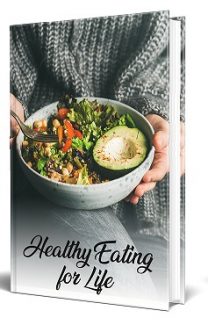
 License Type: Private Label Rights
License Type: Private Label Rights  File Type: ZIP
File Type: ZIP
 SKU: 65186
SKU: 65186  Shipping: Online Download
Shipping: Online Download
Sample Content Preview
4 PCRM • Healthy Eating For Life
Approximately 80 percent of cancers are due to factors that have been identified and can potentially be controlled, according to the National Cancer Institute. Not only do we have the potential to prevent most cancers, we can also improve the survival rates of people who have cancer. Cancer starts when one cell begins to multiply out of control. It begins to expand into a lump that can invade healthy tissues and spread to other parts of the body. But this deadly disease can often be prevented and, when it occurs, can often be stopped in its tracks.
At least one-third of annual cancer deaths in the United States are due to dietary factors.1 A recent review of diet and cancer shows that much of our risk for colon, breast, and prostate cancer, among other types, is due to dietary factors.2,3 The link between diet and cancer is not new. In January 1892, Scientific American printed the observation that “cancer is most frequent among those branches of the human race where carnivorous habits prevail.” Numerous research studies have since shown that cancer is much more common in populations consuming diets rich in fatty foods, particularly meat and dairy products, and much less common in countries with diets rich in grains, vegetables, and fruits. One reason is that foods affect the action of hormones in the body. They also affect the strength of the immune system. While fruits and vegetables contain a variety of vitamins, minerals, antioxidants, and phytochemicals that protect the body, research shows that, by contrast, animal products contain potentially carcinogenic compounds that may contribute to increased cancer risk.
Established or Suspected
Obesity-Related Cancers4
Breast (postmenopausal)
Prostate (advanced)
Pancreas
Esophagus (adenocarcinoma)
Gastric Cardia (adenocarcinoma)
Endometrium
Colon and Rectum
Liver
Gallbladder
Kidney (renal cell)
Non-Hodgkin’s Lymphoma
Multiple Myeloma
Leukemia
Stomach (men)
Ovary
Uterus
Cervix
Another 30 percent of cancers are caused by tobacco. Lung cancer is the most obvious example, but it is by no means the only one. Cancers of the mouth, throat, kidney, and bladder are also caused by tobacco. Other factors, including physical activity, reproductive and sexual behavior, bacterial and viral infections, and exposure to radiation and chemicals, may also contribute to the risk of certain forms of cancer.
PCRM • Healthy Eating For Life 5 Building Your Strength Against Cancer
Some dietary changes have a preventive effect for many types of cancer. Boosting your intake of vitamin-rich vegetables and fruits, for example, strengthens your immune system and helps knock out cancer cells. To help prevent cancer, it is also smart to avoid meats, dairy products, and fried foods. Choosing fiberrich legumes, grains, vegetables, and fruits helps keep many types of cancer at bay. Plant foods also contain a wide variety of cancer-fighting substances called phytochemicals.
These facts all point to choosing a vegetarian diet to help prevent cancer and improve cancer survival. Studies of vegetarians show that death rates from cancer are only about one-half to three-quarters of those of the general population. Breast cancer rates are dramatically lower in countries such as China and Japan, where diets are typically based on rice, vegetables, and bean products, with very little use of meat, dairy products, or oily foods. When people from those countries adopt a Western, meat-based diet, their breast cancer rates soar.
Are you ready to start enjoying the powerful benefits of a vegetarian diet? See “The Three-Step Way to Go Vegetarian” on page 13.
Defending Your DNA From Harm
Let’s look at the steps we can take to build our general defenses. Oxygen is essential to life. But as oxygen is used in the body, some of the oxygen molecules become very unstable. These unstable molecules, called free radicals, can attack cell membranes and even damage the DNA (our genetic code) in the nucleus of the cell. Damage to DNA is the beginning of cancer.
Fortunately, the foods we eat can help protect our bodies. Antioxidants, including vitamin C, vitamin E, beta-carotene, selenium, lycopene, and others, can neutralize the damaging effects of oxygen. These powerful natural chemicals come to us in vegetables, fruits, grains, and beans. People who include fruits and vegetables in their daily diets have lower rates of many forms of cancer.
Smokers have provided dramatic demonstrations of the power of vegetables and fruits. A 55-year-old male smoker whose diet is low in vitamin C has a one-in-four risk of dying of lung cancer in the next 25 years. But if the smoker has a high intake of vitamin C, either through diet or supplements, his risk drops to 7 percent. Effects of antioxidants have even been seen in childhood. When children with brain tumors were studied, it was found that their mothers consumed less vitamin C during pregnancy, compared to other women.
To step up the antioxidant power of your menus, try a baked sweet potato, Low-Fat Guacamole, or baked corn chips with Colorful Corn Salsa (recipes on page 17).
Even with vegetables and fruits in the diet, damage to the cells’ DNA will occasionally occur, so the body has built-in repair machinery. Fixing damaged DNA, which could otherwise cause cancer, requires a B vitamin called folic acid, which is found in dark green leafy vegetables, fruits, peas, and beans. Recent evidence suggests that folic acid may be particularly important in preventing HPV-related cervical cancer.8
The Dietary Reference Intake for folic acid for adult women and men is 400 micrograms per day and increases to 600 micrograms per day for pregnant women. Beans and vegetables are rich in folic acid. Asparagus, black beans, black-eyed peas, chickpeas, lentils, pinto beans, and cooked spinach all have more than 200 micrograms in a 1-cup serving.
We are all exposed to cancer-causing chemicals despite our efforts to avoid them. Some people are smokers, and quitting smoking is a vital step for them. But all of us are exposed to chemicals in the air, water, food, and household products, in addition to the carcinogens produced within our bodies as a part of our metabolic processes. While trying to minimize our exposure to carcinogens, we can also shore up our defenses against these assaults by including generous amounts of vegetables and fruits in our diet.
Foods and Immunity
Even if we follow healthy lifestyles, cancer cells will arise in the body from time to time. Luckily, we have white blood cells that roam our bloodstreams looking for these troublemakers. Some white blood cells, called natural killer cells, seek out and destroy cancer cells and bacteria. They engulf and destroy aberrant cells before they can cause damage. The function of natural killer cells and other white blood cells is improved by as little as 30 milligrams of beta-carotene per day—the amount in two large carrots.
Although beta-carotene is safe, even in fairly substantial amounts, the best way to get beta-carotene is not in pills, but in carrots, winter squash, spinach, kale, and the other packages in which nature supplies it. Beta-carotene is only one of perhaps two dozen related substances called carotenoids that occur naturally in vegetables and fruits and have varying degrees of biological activity.
In a research review, cancer experts found significant evidence suggesting that carotenoids help protect against esophageal, lung, and mouth cancers
- License: Private Label Rights
- Category:Ebooks
- Tags:2023 Ebooks With Audio & Video Private Label Rights







